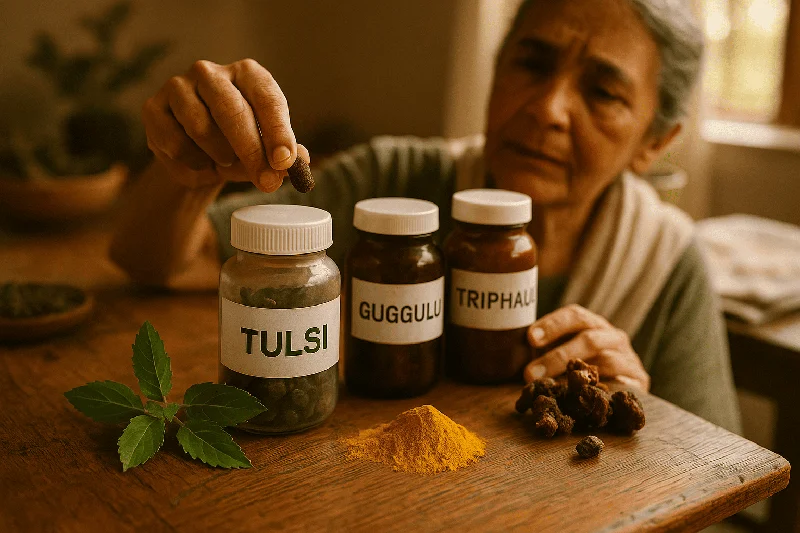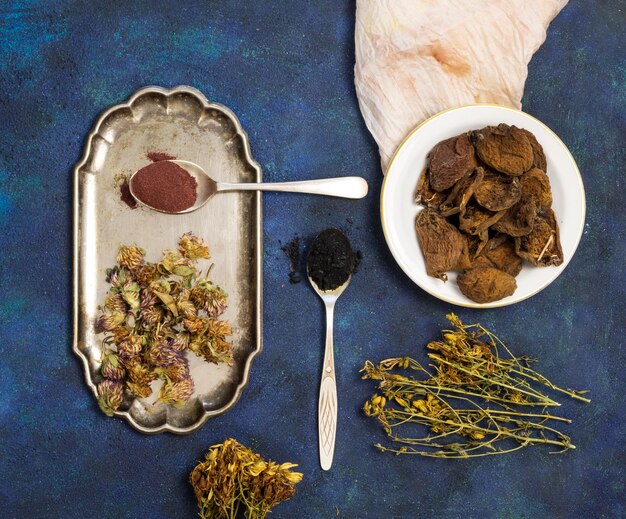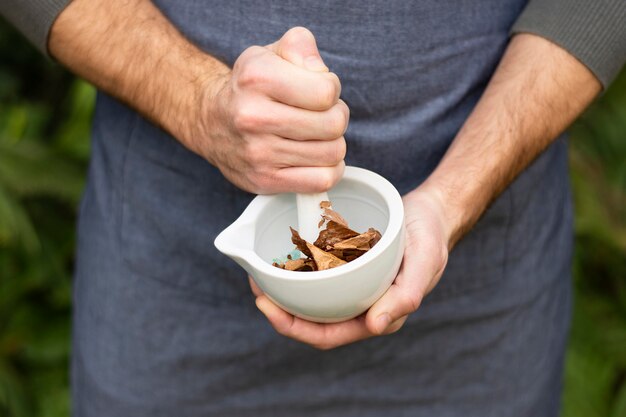अभी हमारे स्टोर में खरीदें
Ayurvedic Medicine for Blood Clots: A Science-Based Overview

Blood clots are a common yet serious health concern, causing conditions like deep vein thrombosis (DVT), pulmonary embolism (PE), and stroke. According to the U.S. Centers for Disease Control and Prevention (CDC), venous thromboembolism—which includes DVT and PE—impacts an estimated 900,000 Americans each year, potentially leading to severe complications if untreated. While conventional medicine offers pharmacological strategies like anticoagulants, many individuals also explore complementary approaches, including ayurvedic medicine for blood clotmanagement.
In this article, we delve into what blood clots are, how Ayurveda interprets circulatory and coagulation disorders, and the growing body of scientific evidence examining the safety and effectiveness of Ayurvedic therapies. You’ll also find balanced insights, potential risks, and practical takeaways to empower informed healthcare decisions.
Disclaimer: The information provided in this article is for educational purposes only and does not substitute professional medical advice. If you suspect a blood clot or have a history of clotting disorders, consult your healthcare provider for personalized guidance.
Table of Contents
- Understanding Blood Clots
- Ayurvedic Perspective on Blood Clot Formation
- Key Ayurvedic Herbs and Formulations
- Scientific Evidence and Research Findings
- Safety, Risks, and Interactions
- Practical Tips for Implementing Ayurvedic Approaches
- Frequently Asked Questions (FAQ)
- Conclusion
Understanding Blood Clots
A blood clot, or thrombus, forms when the blood thickens and coagulates into a gel-like mass. This can occur internally (within veins or arteries) or externally (on the skin as a scab). Clotting is a normal mechanism to stop bleeding, but it becomes problematic when clots form abnormally or fail to dissolve, leading to restricted blood flow.
- Common Risk Factors: Immobility, obesity, smoking, pregnancy, certain medications (e.g., oral contraceptives), cancer, and inherited clotting disorders like Factor V Leiden.
- Typical Symptoms: Swelling, pain, warmth, redness in the affected limb (often in the leg), sudden shortness of breath (if a clot travels to the lung), and chest pain.
Conventional medicine typically involves anticoagulants or blood thinners (e.g., heparin, warfarin, or direct oral anticoagulants) to manage and prevent clot extension. However, an integrative approach may include lifestyle changes, physical therapy, and—in some cases—therapeutic modalities like ayurvedic medicine for blood clot support, under proper medical supervision.
Ayurvedic Perspective on Blood Clot Formation
Ayurveda, a traditional system of medicine with origins in India, is rooted in the balance of three fundamental energies or doshas: Vata, Pitta, and Kapha. In Ayurvedic texts, circulatory disorders can be loosely associated with imbalances in these doshas, particularly Vata (governing movement and circulation) and Pitta (associated with metabolism and transformation, which can include blood quality).
Key Ayurvedic Concepts
- Rakta Dhatu: Refers to the blood tissue and its health. Imbalances in Rakta Dhatu may lead to improper circulation and coagulation anomalies.
- Srotas: Channels or pathways in the body that carry nutrients and waste. In Ayurveda, blockages in these channels can manifest as circulatory disorders.
- Agni (Digestive Fire): A strong agni is believed to aid in proper metabolism, including the breakdown and conversion of nutrients essential for healthy blood formation.
While Ayurveda doesn’t specifically use modern biomedical terms like “blood clot,” it addresses circulatory health through personalized herbal regimens, dietary modifications, yoga, and detoxification therapies (e.g., Panchakarma).
Key Ayurvedic Herbs and Formulations
Several Ayurvedic herbs and formulations are traditionally used to support healthy circulation and potentially mitigate the risks associated with abnormal blood clot formation. Below are some commonly cited options:
-
Turmeric (Curcuma longa)
- Active Compound: Curcumin.
- Traditional Use: Known to support healthy inflammation response and blood flow.
- Modern Insight: Some studies in Phytotherapy Research suggest that curcumin can modulate platelet function and may have mild antithrombotic effects.
-
Guggulu (Commiphora mukul)
- Active Compound: Guggulsterones.
- Traditional Use: Often used for circulatory, joint, and lipid disorders.
- Modern Insight: Preliminary research indicates it can help maintain normal lipid levels, potentially supporting vascular health.
-
Arjuna (Terminalia arjuna)
- Active Compound: Arjunic acid, flavonoids.
- Traditional Use: Revered for its cardioprotective properties. Used in managing heart health and circulation.
- Modern Insight: Studies have shown Arjuna’s benefits in managing heart failure and ischemic heart conditions, although direct evidence on clot prevention is still evolving.
-
Garlic (Allium sativum)
- Active Compound: Allicin.
- Traditional Use: Featured in Ayurveda for improving digestion and heart health.
- Modern Insight: Clinical data (including a 2020 review in the Journal of Nutrition) suggest garlic may have mild antithrombotic properties and help in platelet aggregation control.
-
Ginger (Zingiber officinale)
- Active Compound: Gingerols.
- Traditional Use: Valued for its ability to soothe digestive issues and support circulation.
- Modern Insight: Some in-vitro studies indicate that gingerols could inhibit platelet aggregation, although large-scale human trials are limited.
Popular Formulations
- Triphala: A combination of three fruits (Amalaki, Bibhitaki, Haritaki), widely used for detoxification and bowel regulation, indirectly supporting healthy blood channels.
- Punarnava: Often prescribed to promote diuresis and manage swelling, potentially beneficial in cases of fluid retention and venous stasis.
Note: Research in peer-reviewed journals (e.g., Journal of Ayurveda and Integrative Medicine, BMC Complementary Medicine and Therapies) highlights these herbs’ therapeutic potentials but underscores the need for larger randomized clinical trials to confirm their efficacy in preventing or treating blood clots.
Scientific Evidence and Research Findings
While Ayurveda boasts a long history, rigorous scientific evaluations of Ayurvedic interventions for blood clot prevention or management are still emerging. Here’s a snapshot of current evidence:
-
Clinical Observations
- A handful of small-scale clinical studies have observed improvements in circulation, reduced inflammatory markers, and better lipid profiles in patients taking certain Ayurvedic preparations. However, these studies often have limitations like small sample sizes, lack of placebo control, or short duration.
-
Systematic Reviews
- A 2019 systematic review in the Journal of Alternative and Complementary Medicine highlighted turmeric’s potential in modulating platelet aggregation. Yet, the authors concluded more high-quality, randomized clinical trials are needed.
-
Expert Consensus
- Expert panels, including integrative cardiology forums, suggest that herbs like Arjuna may complement standard heart failure treatments. Still, no authoritative body has issued formal guidelines endorsing Ayurvedic therapies as a primary intervention for clot disorders.
-
Regulatory Status
- Ayurvedic formulations can vary widely in composition. The U.S. Food and Drug Administration (FDA) does not currently regulate Ayurvedic supplements like conventional drugs. Hence, quality and consistency can differ significantly from one product to another.
Safety, Risks, and Interactions
Even “natural” treatments can pose risks if used improperly. When considering ayurvedic medicine for blood clot, keep the following points in mind:
- Medication Interactions: Many Ayurvedic herbs—like turmeric, garlic, and ginger—may have blood-thinning effects that can amplify the effects of prescription anticoagulants (e.g., warfarin, heparin).
- Dosage and Purity: Ayurvedic products may vary in quality, purity, and potency. Selecting products from reputable manufacturers that comply with good manufacturing practices (GMP) is essential.
- Individualized Approach: Ayurveda emphasizes personalized treatment. Self-prescribing without proper consultation may lead to incorrect dosage or combinations, potentially causing adverse effects.
- Contraindications: People with bleeding disorders, upcoming surgeries, or those already on anticoagulant therapy should exercise caution and consult healthcare professionals before adding any herb or supplement.
Practical Tips for Implementing Ayurvedic Approaches
-
Consult an Ayurvedic Practitioner
- Schedule a visit with a qualified practitioner who can assess your doshic balance, medical history, and current medications.
-
Maintain a Balanced Diet
- Ayurveda advocates for freshly cooked, whole foods to support agni (digestive fire). A balanced diet rich in fruits, vegetables, whole grains, and legumes can naturally promote healthy circulation.
-
Stay Hydrated
- Adequate water intake helps maintain healthy blood viscosity, which can be beneficial in minimizing clot risks.
-
Incorporate Moderate Exercise
- Engaging in low-impact exercises like yoga, brisk walking, or gentle stretching improves circulation and can reduce the risk of DVT.
-
Manage Stress
- Stress can exacerbate circulatory issues by elevating inflammatory markers. Practices such as pranayama (breathing exercises) and meditation are staples of Ayurveda for mental and emotional well-being.
-
Monitor Your Health
- If you are at high risk for clots, conduct regular check-ups, including blood tests (such as INR for those on warfarin). This helps you and your healthcare provider track any changes in blood clotting status.
Frequently Asked Questions (FAQ)
1. Can Ayurvedic medicine replace standard anticoagulants?
No. Ayurvedic therapies are typically considered complementary. Prescription anticoagulants are the gold-standard treatment for blood clot prevention and management. Always consult with a healthcare provider before modifying any medical treatments.
2. How long does it take to see results from Ayurvedic remedies?
Results can vary widely, depending on factors like individual constitution (prakriti), severity of imbalance, and overall lifestyle. Some people report improvements in circulation within a few weeks, while others may need longer.
3. Are there any side effects of Ayurvedic herbs for blood clots?
While generally well-tolerated, side effects can include digestive upset or allergic reactions. More importantly, some herbs may intensify the effects of blood thinners, increasing bleeding risk. Consult a professional for personalized advice.
4. Is there any official guideline endorsing ayurvedic medicine for blood clot?
Currently, major health organizations like the World Health Organization (WHO) or the American Heart Association (AHA) do not publish formal guidelines endorsing Ayurvedic medicine specifically for blood clots. Research is ongoing, and new findings may emerge.
5. What lifestyle changes complement Ayurvedic medicine in managing blood clots?
Staying active, avoiding prolonged sitting, maintaining a healthy weight, and adopting stress-reduction techniques like meditation or yoga can complement both Ayurvedic and conventional medical approaches.
Conclusion
The topic of ayurvedic medicine for blood clot management is both fascinating and complex, blending centuries-old wisdom with modern scientific exploration. While certain herbs like turmeric, guggulu, and Arjuna show promise in supporting circulatory health, rigorous clinical data is still evolving. Consequently, integrating Ayurvedic approaches should always be done in tandem with standard medical care, especially when blood clot risks are involved.
If you’re intrigued by the potential of Ayurvedic interventions, the most important step is consulting qualified healthcare professionals—both a conventional doctor and an Ayurvedic practitioner. A collaborative approach ensures you reap the benefits of each system while minimizing risks and interactions.
Call to Action
- Share this article with friends or family who are curious about integrative health approaches.
- Comment below with your experiences or questions about Ayurvedic remedies for blood clots.
- Subscribe to our newsletter for more science-based insights into Ayurveda, herbal medicine, and overall wellness.
Disclaimer: This article is not a substitute for professional medical advice. Always seek the guidance of your physician or another qualified health provider with any questions you may have regarding a medical condition.
Stay informed, stay safe, and embrace a holistic view of health—encompassing the best of both modern medicine and Ayurvedic traditions.
यह लेख वर्तमान योग्य विशेषज्ञों द्वारा जाँचा गया है Dr. Harsha Joy और इसे साइट के उपयोगकर्ताओं के लिए सूचना का एक विश्वसनीय स्रोत माना जा सकता है।
कोई और प्रश्न हैं?
आयुर्वेदिक डॉक्टर से एक प्रश्न पूछें और मुफ़्त या सशुल्क मोड में अपनी चिंता की समस्या पर ऑनलाइन परामर्श प्राप्त करें।
2,000 से अधिक अनुभवी डॉक्टर हमारी साइट पर काम करते हैं और आपके प्रश्नों की प्रतीक्षा करते हैं और प्रतिदिन उपयोगकर्ताओं को उनकी स्वास्थ्य समस्याओं को हल करने में मदद करते हैं।



